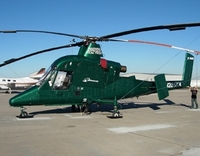Rotor & Wing Special - Japan Misses Early Opportunity to Deploy UAVs at Stricken Fukushima Plant
 |
By Andrew Drwiega, Military Editor
The pictures broadcast around the world of a manned Chinook CH-47 helicopter flying over the stricken, radiation-emitting Fukushima nuclear plant in Japan in the early days of the ongoing disaster filled aviation experts with horror.
Aviation industrialists and observers who are aware of the capabilities of current unmanned aerial vehicles (UAV) saw this situation as the most logical and appropriate use of current proven technology. Surely it would only be a short time before this lifesaving (as far as people battling to control this desperately bad situation were concerned) technology was deployed? They watched and waited. But nothing happened.
The Japan Times online revealed on Monday, April 18 that the U.S. government, through the Department of Defense, working with Lockheed Martin and manufacturer Kaman Aerospace, approached the Japanese government with an offer to supply an unmanned K-MAX helicopter with full support and 20 volunteer specialists to fly to Japan at short notice.
Industry sources have added that the unmanned rotorcraft, which has already undergone stringent cargo carrying tests with the U.S. Marine Corps, could have been deployed early to lift water or even cement above the leaking fuel rods as the Chinook crew were attempting to do, in a bid to try and cover them. With a sensor on the front of the remotely piloted aircraft, and with the operators controlling it from a safe distance, the early efforts to cover the rods could have met with significantly more success.
Negotiations were started, industry readied itself to move at a week’s notice, a concept of operations was drawn up and the volunteers even undertook medical tests to ensure their suitability, but the teams grew more and more frustrated as the negotiations continued. After a further two weeks the team was stood-down. Those primed and ready to go were incredulous. They couldn’t understand why they were not given a chance to contribute to the best of their ability at such a critical time.
Whether there is still a role for the K-MAX to play in the ongoing critical situation remains unclear, as the Japan Times also revealed that it has been considered as a lift platform to install cranes, which will then attempt to extract the fuel rods.


